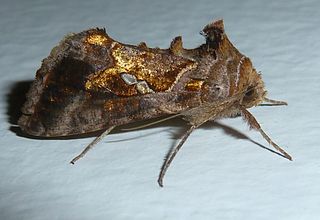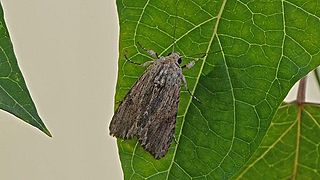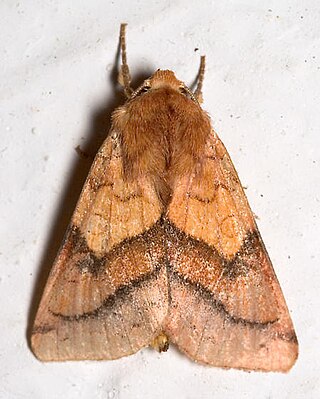
The Noctuidae, commonly known as owlet moths, cutworms or armyworms, are a family of moths. They are considered the most controversial family in the superfamily Noctuoidea because many of the clades are constantly changing, along with the other families of the Noctuoidea. It was considered the largest family in Lepidoptera for a long time, but after regrouping Lymantriinae, Catocalinae and Calpinae within the family Erebidae, the latter holds this title now. Currently, Noctuidae is the second largest family in Noctuoidea, with about 1,089 genera and 11,772 species. This classification is still contingent, as more changes continue to appear between Noctuidae and Erebidae.

Noctuoidea is the superfamily of noctuid or "owlet" moths, and has more than 70,000 described species, the largest number of any Lepidopteran superfamily. Its classification has not yet reached a satisfactory or stable state. Since the end of the 20th century, increasing availability of molecular phylogenetic data for this hugely successful radiation has led to several competing proposals for a taxonomic arrangement that correctly represents the relationships between the major lineages.
Hadeninae was formerly a subfamily of the moth family Noctuidae, but was merged into the subfamily Noctuinae. The tribes Apameini, Caradrinini, Elaphriini, Episemini, Eriopygini, Hadenini, Leucaniini, Orthosiini, and Xylenini were moved from Hadeninae to Noctuinae.

The tomato looper or golden twin-spot moth(Chrysodeixis chalcites) is a moth of the family Noctuidae, subfamily Plusiinae. It mainly lives in southern Europe, the Levant and tropical Africa, but can be seen migrating across much of Europe. In 2013, it was spotted in Canada. It is an important horticultural pest in New Zealand.

Drasteria is a genus of moths in the family Erebidae.

Spodoptera eridania is a moth that is known to be a pest. They are one of the most important defoliators in the tropical and subtropical regions of the western hemisphere that feed heavily on plants while they are young, often resulting in skeleton leaves on their food plants. They are also heavy feeders on tomato in Florida. There is a lot of development in producing pesticides against the S. eridania, specifically a neem-based pesticide that can result in smaller and prolonged development. The wingspan is 33–38 mm. Adults are on wing year-round. The larvae feed on various weeds but prefer Amaranthus species and Phytolacca americana.

Catocala junctura, the joined underwing or Stretch's underwing, is a moth in the family Erebidae. The species was first described by Francis Walker in 1858. It is found throughout temperate North America, ranging from New York and Pennsylvania west to Montana, Colorado, Oklahoma, Arizona, and into Texas, and north to southern Illinois, extreme southern Alberta and Saskatchewan; it has also been recorded west of the Rocky Mountains from California and south-eastern British Columbia. It is typically found near water, where the food plants of its caterpillar larvae grow plentifully.
Autophila limbata is a moth of the family Noctuidae first described by Otto Staudinger in 1871. It is found in southern France, southern Italy, the Iberian Peninsula, Greece, the Crimea, the Near East, Iran, Transcaucasia and Turkmenistan.
Hypocoena stigmatica is a species of moth of the family Noctuidae. It is found on the Faroe Islands and Iceland, as well as parts of Russia and Alaska.

Euxoa cos is a moth of the family Noctuidae. It is found in southern Europe, the Near East and Middle East.

Pyrrhia exprimens, the purple-lined sallow, is a moth of the family Noctuidae. The species was first described by Francis Walker (entomologist) in 1857. In North America it is found from Newfoundland and Labrador west across southern Canada to southern Vancouver Island, south to Texas, Arizona and California. Outside of North America it is found in Finland, the West Siberian plain, the South Siberian Mountains and Kazakhstan.

Raphia frater, the brother moth or simply the brother, is a moth of the family Noctuidae. It is found from Nova Scotia west, across the forested regions of Canada to British Columbia, south to Mississippi in the east. The southern limits in the west are uncertain due to confusion with several closely related species or forms.

Chazaria incarnata is a species of moth of the family Noctuidae. It is found on the Canary Islands and on the Iberian Peninsula, east to Italy, Serbia, Romania, Bulgaria, North Macedonia and Greece. Further east it is found to southern and eastern Russia in the north and Turkey, the Dead Sea region of Israel and Iran.

Lasionycta impingens is a moth of the family Noctuidae. It occurs from southern Yukon to Colorado.

Athetis gluteosa is a moth of the family Noctuidae. It is found from Norway, the Netherlands, Belgium and France, through central and southern Europe to northern Turkey, Transcaucasia, southern Russia, the southern parts of the Ural, southern Siberia, the Korean Peninsula and Japan.

Xestia collina is a moth of the family Noctuidae. It is found in the Alps, from southern France to southern Poland, Romania, from southern Finland and Estonia to the Urals, Siberia and northern Mongolia.

Xestia trifida is a moth of the family Noctuidae. It is found in Romania, Ukraine, southern Russia, Turkey and Turkmenistan as well as the Iberian Peninsula.

The Erebidae are a family of moths in the superfamily Noctuoidea. The family is among the largest families of moths by species count and contains a wide variety of well-known macromoth groups. The family includes the underwings (Catocala); litter moths (Herminiinae); tiger, lichen, and wasp moths (Arctiinae); tussock moths (Lymantriinae), including the arctic woolly bear moth ; piercing moths ; micronoctuoid moths (Micronoctuini); snout moths (Hypeninae); and zales, though many of these common names can also refer to moths outside the Erebidae. Some of the erebid moths are called owlets.

Resapamea hedeni is a moth in the family Noctuidae. It is found from southern Europe to Japan.

Panchrysia aurea is a moth of the family Noctuidae. It is found in southern Europe and western and central Asia. The range extends from Portugal, east to Tian Shan, the Altai and the north-western Himalayas. In central Europe, it is found in the southern Alps, lower Austria and the mountains on the Balkan Peninsula.
















